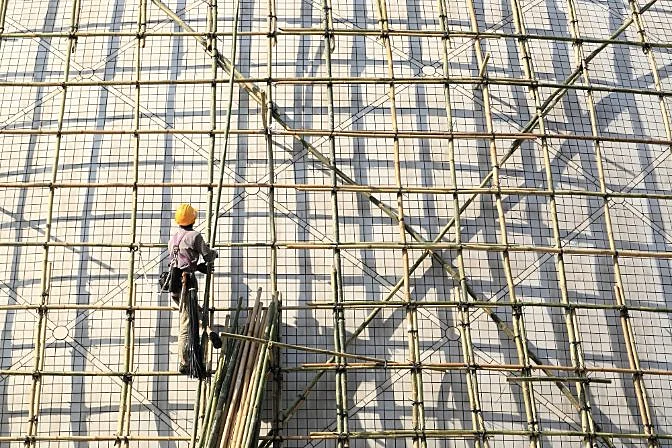Exploring the Different Kinds Of Scaffolding Made Use Of in Building Projects
The building sector counts heavily on different kinds of scaffolding to fulfill certain task requirements, each offering unique advantages and applications. Standard structure scaffolding provides a tough foundation for basic jobs, while put on hold scaffolding is essential for work on high-rise structures.

Conventional Structure Scaffolding
Conventional structure scaffolding is one of one of the most commonly utilized approaches in the building and construction industry as a result of its toughness and flexibility. This system is composed of horizontal and vertical frameworks that are constructed to develop a steady platform for materials and workers. The primary components include upright messages, straight ledgers, and angled braces, which with each other supply a solid framework that can sustain substantial loads.
Among the essential benefits of traditional frame scaffolding is its versatility to different building and construction jobs, varying from residential structures to large commercial structures. The modular design enables easy assembly and disassembly, making it effective for both temporary and long-lasting tasks. In addition, the system can be personalized in elevation and size, suiting various building styles and site conditions.
Security is vital in scaffolding applications, and traditional frame systems are outfitted with guardrails and toe boards to protect against drops and make certain employee defense. Furthermore, routine evaluations and adherence to security policies are important in keeping the stability of the scaffold. On the whole, traditional structure scaffolding continues to be a fundamental option in the building market, offering a trustworthy system for labor and boosting overall project efficiency

Suspended Scaffolding
Suspended scaffolding offers a distinct remedy for construction tasks that require access to elevated surface areas, specifically in circumstances where traditional frame scaffolding may be not practical. This type of scaffolding is generally put on hold from the roof or top degrees of a structure, using a system of wheels, ropes, and platforms to create a functioning room that can be adapted to various elevations.
One of the main benefits of put on hold scaffolding is its flexibility. It can be quickly repositioned or reduced to suit adjustments in building demands, making it ideal for tasks such as home window installation, façade job, and upkeep on skyscraper buildings. In addition, the minimal impact of suspended scaffolding enables much better usage of ground area in metropolitan atmospheres, where room is usually limited.
Security is an essential factor to consider in using put on hold scaffolding. Appropriate rigging and anchoring systems need to be utilized to make sure stability and avoid accidents. Operators should additionally be learnt the secure use this tools. On the whole, suspended scaffolding supplies a effective and effective option for accessing hard-to-reach areas in numerous construction circumstances, enhancing both efficiency and security on website.
System Scaffolding
System scaffolding, often concerned as a modern-day option in the scaffolding market, includes pre-engineered components that can be swiftly put together and adjusted for numerous building jobs. Scaffolding. This kind of scaffolding is characterized by its modular layout, which enables for flexibility and efficiency on work websites, fitting different elevations and structural needs
Normally made from high-strength steel or aluminum, system scaffolding provides improved longevity and security. The elements consist of upright blog posts, straight ledgers, and diagonal braces, which adjoin safely, ensuring a robust structure. The style often includes standardized fittings, streamlining assembly and disassembly processes, thereby minimizing labor time and prices.

Rolling Scaffolding
Moving scaffolder run over scaffolding is a functional alternative to typical set scaffolding, made for mobility and simplicity of usage on building and construction websites. This sort of scaffolding includes a platform supported by structures with wheels, allowing workers to conveniently move it as required. The wheelchair function considerably enhances productivity, as it reduces downtime related to dismantling and assembling fixed scaffolding.
Typically constructed from lightweight materials such as light weight aluminum or steel, rolling scaffolding uses a sturdy yet portable solution for tasks requiring frequent repositioning - Scaffolding. It is specifically useful in tasks such as painting, drywall setup, and electric work, where access to various heights and places is needed
Safety is extremely important in rolling scaffolding layout, with attributes such as locking wheels to stop unexpected movement when in use, and guardrails to protect employees from falls. In addition, many versions are adjustable in elevation, suiting different task requirements.
Cantilever Scaffolding

The design of cantilever scaffolding commonly entails utilizing brackets or arms secured to a structure or structure, allowing the platform to extend exterior safely. Security is critical; hence, these scaffolds need to be crafted to endure various loads and ecological problems. Routine examination and upkeep are vital to guarantee architectural stability and worker safety and security.
Cantilever scaffolding is favored for its convenience and effective use room, making it a prominent selection in urban atmospheres where area restrictions prevail. In addition, it assists in easier access to high altitudes, inevitably adding to the general performance of construction projects. As with all scaffolding kinds, proper training and adherence to safety standards are critical for workers utilizing cantilever scaffolding.
Final Thought
Finally, the varied types of scaffolding made use of in construction jobs each offer unique functions customized Recommended Reading to particular site demands. Standard frame scaffolding gives security, while put on hold scaffolding provides adaptability for raised tasks. System scaffolding facilitates fast setting up, and rolling scaffolding boosts mobility for varying workplace. Cantilever scaffolding successfully resolves obstacles in city setups. Recognizing these scaffolding kinds is vital for optimizing safety and productivity in building, eventually adding to the effective completion of tasks.
Standard framework scaffolding supplies a tough foundation for general tasks, while suspended scaffolding is important for job on high-rise structures.Rolling scaffolding is a versatile alternative to traditional fixed scaffolding, developed for movement and convenience of use on building and construction websites. As with all scaffolding types, correct training and adherence to safety and security standards are critical for workers using cantilever scaffolding.
Standard frame scaffolding gives security, while suspended scaffolding supplies adaptability for elevated jobs. System scaffolding helps with fast setting up, and rolling scaffolding boosts flexibility for differing job environments.
Comments on “Temporary Roof Scaffolding to Ensure Safe Working Conditions During Projects”